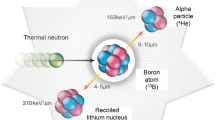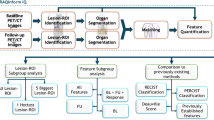Abstract
Purpose
To estimate and reduce uncertainties of a self-consistent set of radiobiological parameters based on the outcome of head and neck cancer (HNC) patients treated with radiotherapy (RT).
Methods
Published studies comparing at least two RT schedules for HNC patients were selected. The method used to estimate the radiobiological parameters consists of three sequential steps that allow a significant reduction of uncertainties: the first, in which the intrinsic (α) and the repair (β) radio-sensitivities were estimated together with the doubling time (T d) by an analytical/graphical method; the second, in which the kick-off time for accelerated proliferation (T k) was estimated applying the hypothesis of activation for sub-populations of stem cells during the RT; the third, in which the number of clonogens (N) was obtained by the Tumor Control Probability (TCP) model. Independent clinical data were used to validate results.
Results
The best estimate and the 95 % confidence intervals (95 % CIs) were: α = 0.24 Gy−1 (0.23–0.26), β = 0.023 Gy−2 (0.021–0.025), α/β = 10.6 Gy (8.4–12.6), T d = 3.5 days (3.1–3.9), T k = 19.2 days (15.1–23.3), N = 7 × 107 (4 × 107–1 × 108). From these data, the dose required to offset repopulation occurring in 1 day (D prolif) and starting after T k was also estimated as 0.69 Gy/day (0.52–0.86).
Conclusions
The estimation of all the radiobiological parameters of HNC was obtained based on the hypothesis of activation for specifically tumorigenic sub-populations of stem cells. The similarity of results to those from other studies strengthens such a hypothesis that could be very useful for the predictivity of the TCP model and to design new treatment strategies for HNC.



Similar content being viewed by others
References
Withers HR. Biologic basis for altered fractionation schemes. Cancer. 1985;55:2086–95.
Million RR, Cassisi NJ, Mancuso AA. Oral cavity. In: Million RR, Cassisi NJ, editors. Management of head and neck cancer: a multidisciplinary approach. 2nd ed. Philadelphia: J.B. Lippincott; 1994. p. 321–400.
Fowler JF. Is there an optimum overall time for head and neck radiotherapy? A review, with new modeling. Clin Oncol. 2007;19:8–22.
Fu KK, Pajak TF, Trotti A, Jones CU, Spencer SA, Phillips TL, et al. A radiation therapy oncology group (RTOG) phase III randomized study to compare hyperfractionation and two variants of accelerated fractionation to standard fractionation radiotherapy for head and neck squamous cell carcinomas: first report of RTOG 9003. Int J Radiat Oncol Biol Phys. 2000;48:7–16.
Marcial VA, Pajak TF, Chang C, Tupchong L, Stetz J. Hyperfractionated photon radiation therapy in the treatment of advanced squamous cell carcinoma of the oral cavity, pharynx, larynx, and sinuses, using radiation therapy as the only planned modality: preliminary report by the Radiation Therapy Oncology Group (RTOG). Int J Radiat Oncol Biol Phys. 1987;13:41–7.
Cox JD, Pajak TF, Marcial VA, Hanks GE, Mohiuddin M, Fu KK, et al. Dose-response for local control with hyperfractionated radiation therapy in advanced carcinomas of the upper aero digestive tracts: preliminary reportof Radiation Therapy Oncology Group protocol 83-13. Int J Radiat Oncol Biol Phys. 1990;18:515–21.
Overgaard J, Hansen HS, Specht L, Overgaard M, Grau C, Andersen E, et al. Five compared with six fractions per week of conventional radiotherapy of squamous-cell carcinoma of head and neck: DAHANCA 6 & 7 randomised controlled trial. Lancet. 2003;362:933–40.
Pedicini P, Nappi A, Strigari L, Jereczek-Fossa BA, Alterio D, Cremonesi M, et al. Correlation between EGFr expression and accelerated proliferation during radiotherapy of head and neck squamous cell carcinoma. Radiat Oncol. 2012;24:143.
Pedicini P, Strigari L, Benassi M. Estimation of a self-consistent set of radiobiological parameters from hypofractionated versus standard radiation therapy of prostate cancer. Int J Radiat Oncol Biol Phys. 2013;85:e231–7.
Pedicini P, Fiorentino A, Simeon V, Tini P, Chiumento C, Pirtoli L, et al. Clinical radiobiology of glioblastoma multiforme: estimation of tumor control probability from various radiotherapy fractionation schemes. Strahlenther Onkol. 2014;190(10):925–32.
Pedicini P. In regard to Pedicini et al. Int J Radiat Oncol Biol. 2013;87(5):858.
Efron B. Censored data and the bootstrap. J Am Stat Assoc. 1981;76:312–9.
Dische S, Saunders M, Barrett A, Harvey A, Gibson D, Parmar M. A randomised multicentre trial of CHART versus conventional radiotherapy in head and neck cancer. Radiother Oncol. 1997;44(2):123–36.
Awwad HK, Lotayef M, Shouman T, Begg AC, Wilson G, Bentzen SM, et al. Accelerated hyperfractionation (AHF) compared to conventional fractionation (CF) in the postoperative radiotherapy of locally advanced head and neck cancer: influence of proliferation. Br J Cancer. 2002;86:517–23.
Chung CH, Zhang Q, Hammond EM, Trotti AM 3rd, Wang H, Spencer S, et al. Integrating epidermal growth factor receptor assay with clinical parameters improves risk classification for relapse and survival in head-and-neck squamous cell carcinoma. Int J Radiat Oncol Biol Phys. 2011;81:331–8.
Pinto LH, Canary PC, Araújo CM, Bacelar SC, Souhami L. Prospective randomized trial comparing hyperfractionated versus conventional radiotherapy in stages III and IV oropharyngeal carcinoma. Int J Radiat Oncol Biol Phys. 1980;21:557–62.
Horiot JC, Le Fur R, N’Guyen T, Chenal C, Schraub S, Alfonsi S, et al. Hyperfractionation versus conventional fractionation in oropharyngeal carcinoma: final analysis of a randomized trial of the EORTC cooperative group of radiotherapy. Radiother Oncol. 1992;25(4):231–41.
Jackson SM, Weir LM, Hay JH, Tsang VH, Durham JS. A randomized trial of accelerated versus conventional radiotherapy in head and neck cancer. Int J Radiat Oncol Biol Phys. 1997;43:39–46.
Horiot JC, Bontemps P, van den Bogaert W, Le Fur R, van den Weijngaert D, Bolla M, et al. Accelerated fractionation (AF) compared to conventional fractionation (CF) improves loco-regional control in the radiotherapy of advanced head and neck cancers: results of the EORTC 22851 randomized trial. Radiother Oncol. 1997;44:111–21.
Katori H, Tsukuda M, Watai K. Comparison of hyperfractionation and conventional fractionation radiotherapy with concurrent docetaxel, cisplatin and 5-Xuorouracil (TPF) chemotherapy in patients with locally advanced squamous cell carcinoma of the head and neck (SCCHN). Cancer Chemother Pharmacol. 2007;60:399–406.
Cummings B, Keane T, Pintilie M, Warde P, Waldron J, Payne D, et al. Five year results of a randomized trial comparing hyperfractionated to conventional radiotherapy over four weeks in locally advanced head and neck cancer. Radiother Oncol. 2007;85(1):7–16.
Bentzen SM, Atasoy BM, Daley FM, Dische S, Richman PI, Saunders MI, et al. Epidermal growth factor receptor expression in pretreatment biopsies from head and neck squamous cell carcinoma as a predictive factor for a benefit from accelerated radiation therapy in a randomized controlled trial. J Clin Oncol. 2005;23:5560–7.
Withers HR, Taylor JMG, Maciejewski B. The hazard of accelerated tumor clonogen repopulation during radiotherapy. Acta Oncol. 1988;27:131–46.
Trott KR. Perspectives of experimental research on repopulation during radiotherapy. Int J Radiat Biol. 2003;79:577–80.
Bourhis J, Overgaard J, Audry H, Ang KK, Saunders M, Bernier J, et al. Hyperfractionated or accelerated radiotherapy in head and neck cancer: a meta-analysis. Lancet. 2006;368(9538):843–54.
Steel GG. Growth kinetics of tumours. Oxford: Clarendon-Press; 1977.
Pedicini P, Fiorentino A, Improta G, Nappi A, Salvatore M, Storto G. Estimate of the accelerated proliferation by protein tyrosine phosphatase (PTEN) over expression in postoperative radiotherapy of head and neck squamous cell carcinoma. Clin Transl Oncol. 2013;15(11):919–24.
Conflict of interest
The authors declare no competing interests.
Author information
Authors and Affiliations
Corresponding author
Rights and permissions
About this article
Cite this article
Pedicini, P., Caivano, R., Fiorentino, A. et al. Clinical radiobiology of head and neck cancer: the hypothesis of stem cell activation. Clin Transl Oncol 17, 469–476 (2015). https://doi.org/10.1007/s12094-014-1261-z
Received:
Accepted:
Published:
Issue Date:
DOI: https://doi.org/10.1007/s12094-014-1261-z




